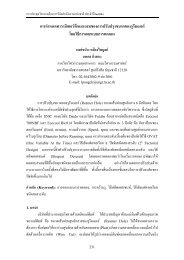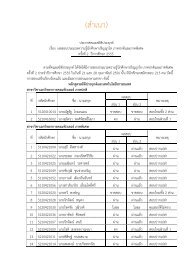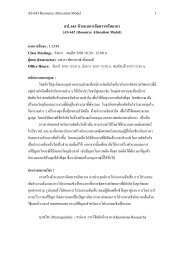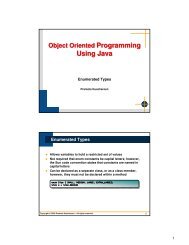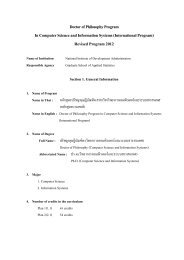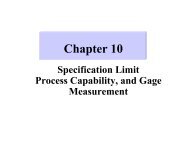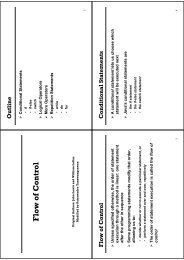ดาวน์โหลด All Proceeding - AS Nida
ดาวน์โหลด All Proceeding - AS Nida
ดาวน์โหลด All Proceeding - AS Nida
Create successful ePaper yourself
Turn your PDF publications into a flip-book with our unique Google optimized e-Paper software.
investigate the performance of the FA with different parameter setting<br />
and compare with best known solution from literature review. A job<br />
shop scheduling tool was written in modular style using Tcl/Tk<br />
programming language. The computational experiment was designed<br />
and conducted using five benchmarking datasets of the JSSP instance<br />
from the well-recognised OR-Library published by Beasley [11].<br />
The remaining sections in this paper are organised as<br />
follows. Section 2 reviews the literature relating to job shop scheduling<br />
problems. Section 3 describes the procedures of the Firefly Algorithm<br />
(FA) and its pseudo code for solving the JSSP. Section 4 presents the<br />
experimental design and analyses results. Finally, section 5 draws the<br />
conclusions of the research and suggests possible further work.<br />
2. Job shop scheduling problems (JSSP)<br />
Shop floor scheduling problems can be classified into four<br />
main categories [12]: (i) single-machine scheduling (ii) flow-shop<br />
scheduling (iii) job-shop scheduling and (iv) open-shop scheduling.<br />
Single-machine scheduling is the simplest shop scheduling problem, in<br />
which there is only one available machine for servicing the arriving<br />
jobs. In flow-shop scheduling, jobs are processed on multiple machines<br />
in an identical sequence. Job-shop scheduling is a general case of flowshop<br />
scheduling, in which the sequencing of each job through the<br />
machines is not necessarily identical. The open-shop scheduling is<br />
similar to the job-shop scheduling except that a job may be processed<br />
on the machines in any sequence the job needs. Since the job-shop<br />
scheduling is commonly found in many real-world businesses and/or<br />
manufacturing industry, this problem was proposed in this paper.<br />
Although JSSP is common found but it is very difficult work<br />
to construct the best schedule within limited resources. The complexity<br />
of JSSP is increasing with the number of constraints defined and the<br />
size of search space operated. JSSP is known as one of the most<br />
difficult Non-deterministic Polynomial (NP) hard problem [13, 14], in<br />
which the amount of computation required increases exponentially with<br />
problem size. The JSSP can be described as follow: a classical n-job mmachine<br />
(n×m) JSSP consists of a finite set [J j] 1≤j≤n of n independent<br />
jobs or tasks that must be processed in a finite set [M k] 1≤k≤m of m<br />
machines. The problem can be characterised as follows [15]: each job j<br />
∈ J must be processed by every machines k ∈ M; the processing of<br />
job J j on machine M k is called the operation O jk; operation O jk requires<br />
the exclusive use of machine M k for an uninterrupted duration t jk, its<br />
processing time; each job consists of a sequence of x j operations; O jk can<br />
90<br />
be processed by only one machine k at a time (disjunctive constraint);<br />
each operation, which has started, runs to completion (non-preemption<br />
condition); and each machine performs operations one after another<br />
(resource/capacity constraint).<br />
An example of two jobs to be performed three machines<br />
(2×3) job shop scheduling problem is illustrated in Table 1. In this<br />
problem, each job requires three operations to be processed on a predefined<br />
machine sequence. The first job (J 1) need to be initially<br />
operated on the machine M 1 for 5 time units and then sequentially<br />
processed on M 2 and M 3 for 4 and 9 time units, respectively. Likewise,<br />
the second job (J 2) has to be initially performed on M 3 for 5 time units<br />
and sequentially followed by M 1 and M 2 for 6 and 7 time units,<br />
respectively. The design task for solving JSSP is to search for the best<br />
schedule(s) for operating all pre-defined jobs in order to optimise either<br />
single or multiple scheduling objectives, which is used for identifying a<br />
goodness of schedule such as the minimisation of the makespan (C max).<br />
Figure 1 shows another example on machine routings of a larger size of<br />
(3×6) job shop scheduling problem.<br />
Table 1. An example of 2-jobs 3-machines scheduling problem with<br />
processing times.<br />
Job (Jj) Operation (Ojk) Time (tjk) Machine (Mk) M1 M2 M3 O11 5 5 - -<br />
J1 O12 4 - 4 -<br />
O13 9 - - 9<br />
O23 5 - - 5<br />
J2 O21 6 6 - -<br />
O22 7 - 7 -<br />
Figure 1. Another example of the machine routings for 3-jobs<br />
6-machines scheduling problem.




